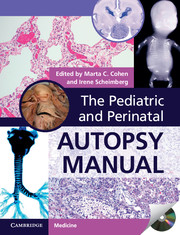Book contents
- Frontmatter
- Contents
- List of contributors
- Foreword
- Preface
- Acknowledgments
- 1 Perinatal autopsy, techniques, and classifications
- 2 Placental examination
- 3 The fetus less than 15 weeks gestation
- 4 Stillbirth and intrauterine growth restriction
- 5 Hydrops fetalis
- 6 Pathology of twinning and higher multiple pregnancy
- 7 Is this a syndrome? Patterns in genetic conditions
- 8 The metabolic disease autopsy
- 9 The abnormal heart
- 10 Central nervous system
- 11 Significant congenital abnormalities of the respiratory, digestive, and renal systems
- 12 Skeletal dysplasias
- 13 Congenital tumors
- 14 Complications of prematurity
- 15 Intrapartum and neonatal death
- 16 Sudden unexpected death in infancy
- 17 Infections and malnutrition
- 18 Role of MRI and radiology in post mortems
- 19 The forensic post mortem
- 20 Appendix tables
- Index
- References
15 - Intrapartum and neonatal death
Published online by Cambridge University Press: 05 September 2014
- Frontmatter
- Contents
- List of contributors
- Foreword
- Preface
- Acknowledgments
- 1 Perinatal autopsy, techniques, and classifications
- 2 Placental examination
- 3 The fetus less than 15 weeks gestation
- 4 Stillbirth and intrauterine growth restriction
- 5 Hydrops fetalis
- 6 Pathology of twinning and higher multiple pregnancy
- 7 Is this a syndrome? Patterns in genetic conditions
- 8 The metabolic disease autopsy
- 9 The abnormal heart
- 10 Central nervous system
- 11 Significant congenital abnormalities of the respiratory, digestive, and renal systems
- 12 Skeletal dysplasias
- 13 Congenital tumors
- 14 Complications of prematurity
- 15 Intrapartum and neonatal death
- 16 Sudden unexpected death in infancy
- 17 Infections and malnutrition
- 18 Role of MRI and radiology in post mortems
- 19 The forensic post mortem
- 20 Appendix tables
- Index
- References
Summary
Introduction
Neonatal deaths may occur as complications of labor (intrapartum asphyxia and/or trauma), neonatal infections (congenital or acquired after birth), complications of prematurity, lethal congenital abnormalities, metabolic diseases, etc. In this chapter we will focus on intrapartum asphyxia and trauma and neonatal infections. For other conditions, refer to the appropriate chapters.
Intrapartum death is the death of an infant once labor has started. This includes a stillborn infant whose death occurs while the mother is undergoing monitoring in labor [1–3]. Generally this is a fresh stillborn infant with no evidence of maceration [4], indicating death within 12 hours of delivery. Intrapartum deaths are rare in Western societies, reflecting the quality and availability of intrapartum care [1,4–6] and are considered potentially preventable [5]. The global annual number is estimated to be in the region of one million [7], although the rate of intrapartum death varies according to the socioeconomic status of the country; in Westernized societies the rate is much lower than poorer countries. In high-income countries, the proportion of intrapartum stillbirths to all stillbirths is under 10%; in low- and middle-income countries it may be as high as one-third [3]. The rates are likely to be affected by confounding factors – for example, if a mother undergoes a long labor exceeding 12 hours with fetal demise early in this labor, the stillborn infant will show signs of maceration and the death may not be included in the intrapartum death category [7].
- Type
- Chapter
- Information
- The Pediatric and Perinatal Autopsy Manual , pp. 298 - 318Publisher: Cambridge University PressPrint publication year: 2000
References
- 1
- Cited by



